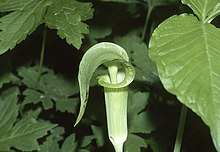User:Chaigood/Sequential hermaphroditism
Sequential Hermaphroditism In Plants
[edit]
Sequential hermaphroditism in plants is the process in which a plant changes its sex throughout its lifetime. Sequential hermaphroditism in plants is very rare. There are less than 0.1% of recorded cases in which plant species entirely change their sex. [1] The Patchy Environment Model and Size Dependent Sex Allocation are the two environmental factors which drive sequential hermaphroditism in plants. The Patchy Environment Model states that plants will want to maximize the use of their resources through the change of their sex. For example, if a plant will benefit more from the resources of a given environment in a certain sex, it will want to change to that sex. Furthermore, Size Dependent Sex Allocation outlines that in sequential hermaphroditic plants, it is preferable to change sexes in a way that maximizes their overall fitness compared to their size over time. [2] Similar to maximizing the use of resources, if the combination of size and fitness for a certain sex is more beneficial, the plant will want to change to that sex. Evolutionarily, sequential hermaphrodites emerged as certain species found that one of the best ways to maximize the benefits of their environment was through changing their sex.

Arisaema
[edit]Arisaema is a plant family which is commonly cited as exercising sequential hermaphroditism.[3] The most commonly known Arisaema plant is the Jack in the pulpit or Arisaema triphyllum plant. [4][5] As the A. Triphyllum grows and evolves, they develop from "nonsexual juvenile plants," to young all male plants, to both male and female plants, to all female plants.[6] This means that A. Triphyllum is changing its sex from male to female over the course of their lifetime as their size increases, showcasing Size Dependent Sex Allocation. Another example is Arisaema dracontium or the green dragon, which can change its sex on a yearly basis.[7] A. Dracontium's sex is also dependent on size: the smaller flowers are male while the larger flowers are both male and female. [8] Typically in Arisaema species, small flowers only contain stamens, meaning they are males. Larger flowers can contain both stamen and pistils or only pistils, meaning they can be either hermaphrodites or strictly female. [9] Overall, Arisaemas are changing their sex as they grow larger, maximizing the overall fitness for that particular environment.[10]
Striped Maple (Acer Pensylvanicum)
[edit]
The Striped Maple or Acer pensylvanicum are sequential hermaphrodites as they are known to have the ability to change sexes.[11] Starting in 2014, a case study showed that over a four year time span 54% of striped maple trees developed a different sex.[12] Scientists removed branches from striped maple trees to research the cause of their sequential hermaphroditism.[13] It was found that the branches changed to either female or female and male as a response to being damaged by being cut off the tree. [14] Researchers concur that when the striped maple experiences damage or is sick, this will trigger a sex change to either female or female and male. [15] This could be because the striped maple would want to bloom as quickly as possible, passing on its offspring, before it ultimately dies from these damages or sickness. [16]
- ^ Jong, Thomas Johannes de. (2005). Evolutionary ecology of plant reproductive strategies. Klinkhamer, Petrus Gerardus Leonardus. Cambridge: Cambridge University Press. ISBN 0521821428. OCLC 61702406.
- ^ Plant reproductive ecology : patterns and strategies. Lovett Doust, Jon., Lovett Doust, Lesley. New York: Oxford University Press. 1988. ISBN 0195051750. OCLC 16710791.
{{cite book}}: CS1 maint: others (link) - ^ Srivastava, Preeti; Banerji, B. K. (2012). "Gender biasing in Arisaema – a unique and rare phenomenon". Current Science. 102 (2): 189–193. ISSN 0011-3891.
- ^ Srivastava, Preeti; Banerji, B. K. (2012). "Gender biasing in Arisaema – a unique and rare phenomenon". Current Science. 102 (2): 189–193. ISSN 0011-3891.
- ^ Newman, Paul B. (1956). "Urashima Taro". Chicago Review. 10 (2): 52. doi:10.2307/25293222. ISSN 0009-3696.
- ^ Srivastava, Preeti; Banerji, B. K. (2012). "Gender biasing in Arisaema – a unique and rare phenomenon". Current Science. 102 (2): 189–193. ISSN 0011-3891.
- ^ Srivastava, Preeti; Banerji, B. K. (2012). "Gender biasing in Arisaema – a unique and rare phenomenon". Current Science. 102 (2): 189–193. ISSN 0011-3891.
- ^ Srivastava, Preeti; Banerji, B. K. (2012). "Gender biasing in Arisaema – a unique and rare phenomenon". Current Science. 102 (2): 189–193. ISSN 0011-3891.
- ^ Srivastava, Preeti; Banerji, B. K. (2012). "Gender biasing in Arisaema – a unique and rare phenomenon". Current Science. 102 (2): 189–193. ISSN 0011-3891.
- ^ Srivastava, Preeti; Banerji, B. K. (2012). "Gender biasing in Arisaema – a unique and rare phenomenon". Current Science. 102 (2): 189–193. ISSN 0011-3891.
- ^ "Striped Maple Trees Often Change Sexes, With Females More Likely to Die". Rutgers Today. 2019-05-29. Retrieved 2019-10-31.
- ^ "Striped Maple Trees Often Change Sexes, With Females More Likely to Die". Rutgers Today. 2019-05-29. Retrieved 2019-10-31.
- ^ Treviño, Julissa. "The Mystery of the Sex-Changing Striped Maple Trees". Smithsonian. Retrieved 2019-12-06.
- ^ Treviño, Julissa. "The Mystery of the Sex-Changing Striped Maple Trees". Smithsonian. Retrieved 2019-12-06.
- ^ Treviño, Julissa. "The Mystery of the Sex-Changing Striped Maple Trees". Smithsonian. Retrieved 2019-12-06.
- ^ Treviño, Julissa. "The Mystery of the Sex-Changing Striped Maple Trees". Smithsonian. Retrieved 2019-12-06.
